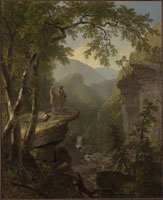
This exhibition is no longer on view at the National Gallery. Please follow the links below for related online resources or visit our current exhibitions schedule.
In appreciation of Bryant's eulogy of Cole, who died an untimely death from pneumonia in 1848, New York dry-goods merchant and art collector Jonathan Sturges commissioned Durand to capture the friendship of the painter and poet. The painting remained in the Bryant family until Bryant's daughter, Julia, donated it to the New York Public Library in early 1904. Sturges' request that Cole and Bryant be shown as "kindred spirits" was inspired by the English poet John Keats' "Sonnet to Solitude," which celebrates the ameliorative aspects of nature and concludes:
Yet
the sweet converse of an innocent mind,
Those words are images of thoughts refin'd,
Is my soul's a pleasure; and sure it must be
Almost the highest bliss of human-kind,
When to thy haunts two kindred spirits flee.
Kindred Spirits is regarded as a defining work of the Hudson River School. Although executed in the detailed and realistic style that Durand championed for the American landscape school, the painting's idealized composition brings together several sites—including the Clove of the Catskills and Kaaterskill Falls—in a way that is not geographically possible. It was intended as a tribute to American nature and to the two men who had celebrated its special beauties.
Kindred Spirits embodies the intimate connection of Durand, Bryant, and Cole. Durand (1796–1886), several years older than Cole and a successful engraver, had been inspired by Cole in the 1830s to take up landscape painting, and was soon a leading practitioner in his own right. Durand's Kindred Spirits paid homage first and foremost to Cole's ability as a painter of American wild scenery, as typified by Cole's A View of the Mountain Pass Called the Notch of the White Mountains (1839), on view in the National Gallery's American collection. The three men had collaborated on "The American Landscape," a collection of vignettes published in 1830 by the New York-based Sketch Club, based in New York.
The influence of both Cole and Durand bore fruit in the works of the generation of painters that matured in the 1850s, particularly John F. Kensett and Jasper Francis Cropsey. The importance of the Hudson River School waned after the Civil War and its leading practitioners looked to the exotic beauty of foreign lands for inspiration. After the 1870s most of the artists associated with the Hudson River School were deemed old fashioned. It was only with the revival of interest in the School during the 1930s and 1940s that works like Kindred Spirits would once again resume their central importance as key monuments in the history of American art.
The Gallery has rich holdings of works by Hudson River School artists Cole (the School's founder), Durand, Kensett, Cropsey, George Inness, Frederic Edwin Church, Albert Bierstadt, and William Trost Richards.



